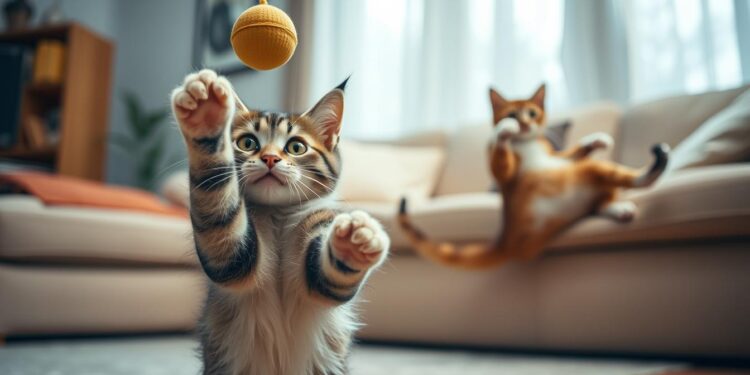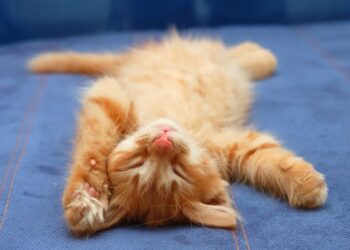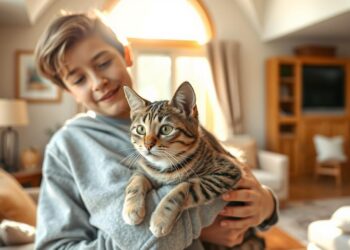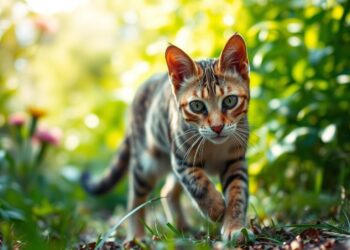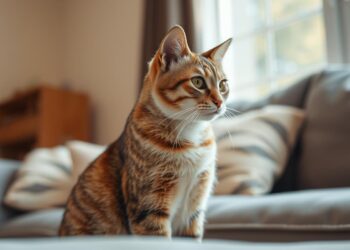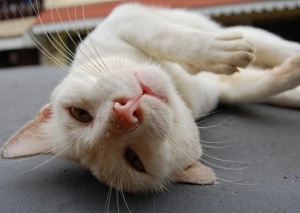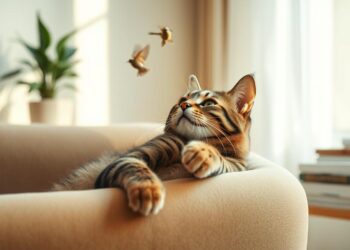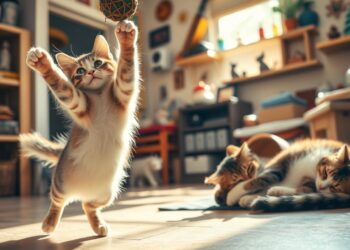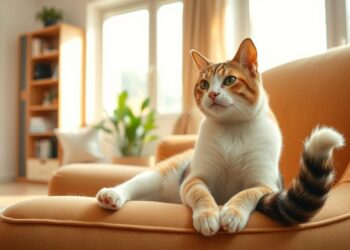Cats are fascinating creatures with unique personalities and sometimes puzzling behaviors. As a pet owner, you might find yourself wondering what’s going on in your feline friend’s mind when they exhibit certain quirky actions.
Understanding these seemingly strange behaviors can strengthen the bond between you and your kitty. Many of these actions are actually perfectly normal expressions of a cat’s natural instincts and evolutionary history.
By exploring the science behind these behaviors, we can better understand our pets’ quirky personalities and provide appropriate outlets for their natural instincts.
Understanding Your Cat’s Quirky Behaviors
Cats often exhibit behaviors that seem bizarre to their owners, but these actions have roots in their wild ancestry. Since domestication has been a relatively recent development for cats, some things they once did to survive may have no adaptive value now. However, these behaviors were once crucial for their survival.
Why Cats Develop Unusual Habits
Cats develop unusual habits due to their genetic predispositions inherited from their wild ancestors. Today’s domestic cats share 95% of their genetic makeup with wild felines, explaining why many domestic behaviors mirror those seen in the wild. Some of these behaviors include:
- Hunting behaviors, such as stalking toys or pouncing on moving objects, remain strongly ingrained even when they’re well-fed.
- The territorial nature of wild cats translates into domestic behaviors like scent marking and scratching furniture.
- Cats’ predatory instincts explain their fascination with small moving objects.
The Link Between Wild Instincts and Domestic Behavior
The behaviors exhibited by domestic cats are closely linked to their wild instincts. Their predatory nature and self-preservation instincts manifest in various ways, such as hiding, climbing to high places, and being startled by sudden movements. Understanding these connections helps explain why certain behaviors can’t simply be “trained out” of cats; they’re hardwired into their nature. Providing appropriate outlets for these natural behaviors is more effective than trying to eliminate them completely.
Zoomies: Why Cats Suddenly Sprint Around the House
Cats often exhibit a peculiar behavior known as “zoomies,” where they suddenly sprint around the house with unbridled energy. This phenomenon is especially common in kittens but can also be observed in adult cats. During these episodes, cats can be seen darting from room to room, jumping up and down on the furniture, and expending a seemingly endless supply of energy.
The Science Behind Nighttime Energy Bursts
The exact cause of zoomies is not fully understood, but it’s believed to be related to the cat’s natural hunting instinct. Cats are most active at dawn and dusk, but domestic cats can exhibit these energetic bursts at any time, including nighttime. To minimize disruptions, it’s essential to provide adequate playtime and stimulation during the day, using a variety of toys to keep your cat engaged.
How to Create Safe Spaces for Cat Zoomies
To prevent injuries and damage during zoomies, it’s crucial to create a safe environment. Here are some tips to achieve this:
- Remove fragile items from shelves and surfaces to prevent accidents.
- Provide dedicated climbing structures like cat trees and wall shelves.
- Designate a “zoomie zone” with open floor space and appropriate toys.
- Make sure furniture is stable and secure to prevent tipping.
By taking these precautions, you can help ensure yourcat’ssafety while allowing them to enjoy their energetic bursts in the comfort of yourhome.
Head Bumping and Face Rubbing: Signs of Feline Affection
Cats often display affection through head bumping and face rubbing, which are significant indicators of their love and trust towards their human companions. These behaviors are not only adorable but also carry important meanings in the feline world.
Beyond head bumping, cats have numerous ways of expressing affection that might not be as obvious to human companions. For instance, a cat’s tail can say a lot about their mood. A relaxed, napping cat might perform a slow, luxurious swaying with their tail.
Scent Marking as a Form of Communication
When your cat rubs their face against you, they are depositing their scent on you, which is a form of communication and marking. This cat behavior signifies that they feel comfortable and secure in your presence.
Different Ways Cats Show Their Love
There are many ways cats show their love beyond head bumping and face rubbing. Some of these include slow blinking or “cat kisses,” a raised tail with a slight curve at the tip when greeting, kneading your lap, bringing you “gifts,” following you from room to room, gentle nibbling or grooming behaviors, and purring when near you.
| Affectionate Behavior | Description |
|---|---|
| Slow Blinking | A sign of trust and contentment |
| Raised Tail | Signals happiness and excitement to see you |
| Kneading | A sign of contentment dating back to kittenhood nursing behaviors |
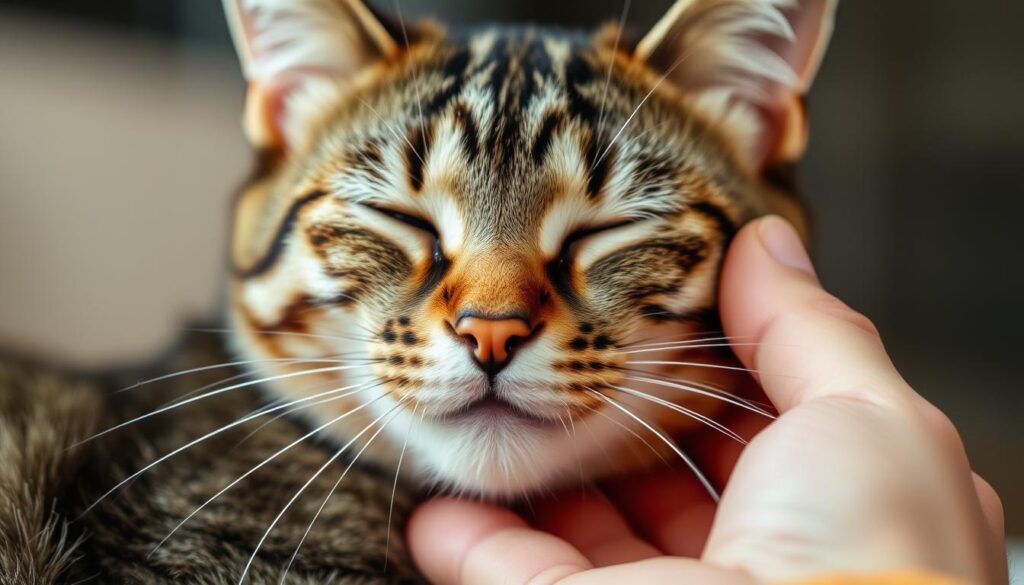
Chattering at Birds: The Predator Within
Cats chattering at birds is a common phenomenon that reveals the complex interplay between their domesticated behavior and wild instincts. This behavior is not just a simple reaction; it’s a multifaceted expression of their predatory nature. When a cat sees a bird, its instincts are triggered, leading to this unique form of communication or expression.
The Frustration-Excitement Response
The chattering behavior is often associated with a mix of frustration and excitement. When a cat is unable to hunt its prey, such as a bird outside a window, it may express its pent-up energy through chattering. This response is a manifestation of the cat’s innate hunting instincts.
Other Strange Noises Your Cat Makes
Beyond chattering, cats produce a variety of unusual vocalizations and sounds that serve different communicative purposes. For instance, the “trilling” sound, a combination of a purr and meow, is typically a friendly greeting or attention-seeking behavior. Other sounds include yowling, hissing, and growling, each indicating different emotional states or needs.
| Sound | Description | Possible Meaning |
|---|---|---|
| Trilling | A mix of purr and meow | Friendly greeting or seeking attention |
| Yowling | Long, drawn-out vocalization | Distress, territorial concern, or mating behavior |
| Hissing/Growling | Defensive sounds | Feeling threatened or uncomfortable |
A weird cat behavior might also involve the “Flehmen response,” where the cat curls back its upper lip, allowing it to analyze scents better. This behavior is a sign of a cat’s highly developed sense of smell and its importance in feline communication. Your kitty might also make “nursing sounds” while kneading, a comforting behavior leftover from kittenhood. It might also be observed that cats make a “silent meow,” a learned behavior to communicate subtly with humans.
Kneading or “Making Biscuits”: Comfort Behavior
Felines often knead with their paws, a behavior that is both soothing for them and sometimes uncomfortable for their owners. Kneading is a natural and comforting action for cats, reminiscent of their kitten days when they used to stimulate milk production from their mother.
This behavior is a sign of contentment and relaxation, indicating that your cat feels safe and at ease. However, when cats knead, they often extend and retract their claws, which can lead to discomfort for humans or damage to furniture.
Kitten Origins of Kneading Behavior
The kneading behavior in cats originates from their early days as kittens. When they were nursing, kneading helped stimulate milk production from their mother. This action became ingrained and is retained into adulthood as a comfort mechanism.
- Kneading is an instinctual behavior that cats develop early in life.
- It is associated with the comfort and security of nursing.
- Adult cats continue to knead as a way to self-soothe.
When Kneading Becomes Uncomfortable
While kneading is a positive sign of your cat’s comfort, it can become problematic if their claws are not properly maintained. To mitigate this, you can keep your cat’s claws trimmed or use a thick blanket as a barrier between their paws and your skin.
- Regular claw trimming can reduce the discomfort caused by kneading.
- Using a protective barrier, like a blanket, can safeguard your skin.
- Soft nail caps can be an effective solution for enthusiastic kneaders.
Weird Cat Habits: Squeezing Into Small Spaces
If you’ve ever wondered why your cat loves hiding in tiny enclosures, you’re not alone. Cats of all types are drawn to small spaces; even lions and cheetahs appear to enjoy squeezing themselves into such cardboard safe places.
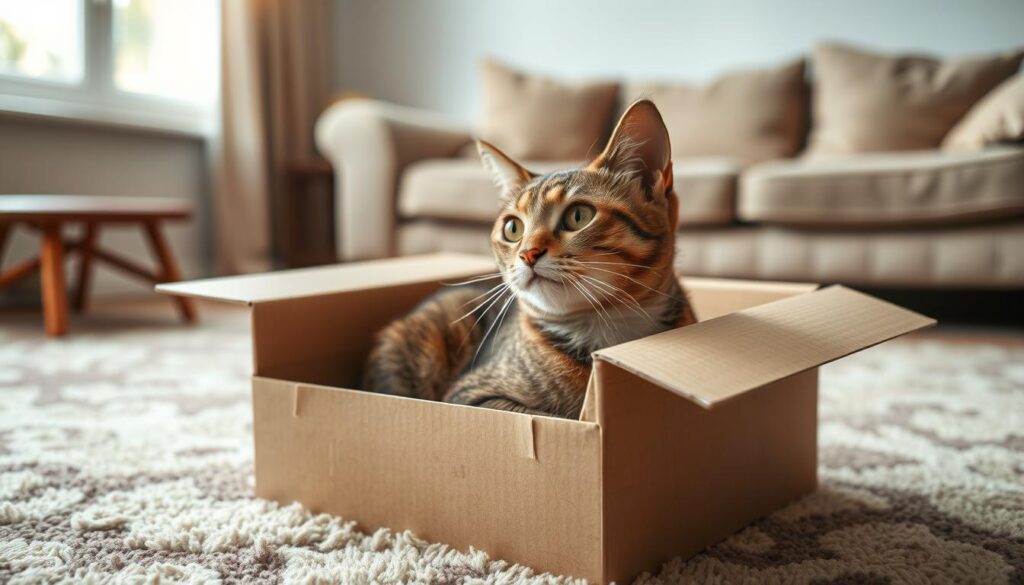
The Security of Tight Spaces
The attraction to boxes is so consistent that researchers have studied this phenomenon, finding it serves multiple psychological and physiological purposes. A 2014 study from the University of Utrecht found that boxes significantly reduced stress in shelter cats by providing a hiding place and sense of control over their environment.
The defined boundaries of a box help cats feel secure by creating a clear territory that they can easily monitor and defend if necessary.
The Box Obsession Explained
Cardboard boxes specifically provide insulation that helps cats maintain their optimal body temperature (around 100-102°F), which is higher than human comfort temperatures. The texture of cardboard also appeals to cats as it provides a satisfying surface for scratching and scent marking.
| Reasons for Box Attraction | Benefits for Cats |
|---|---|
| Defined Boundaries | Creates a sense of security and territory |
| Insulation | Maintains optimal body temperature |
| Texture | Satisfies scratching and scent marking instincts |
Providing appropriate box-like hiding spaces is recommended by veterinary behaviorists as an easy, inexpensive way to reduce stress in multi-cat households or during transitions.
Knocking Things Over: Feline Curiosity in Action
The act of knocking things over is a common feline behavior that stems from their innate curiosity and exploratory nature. Cats are naturally inclined to investigate their surroundings, and this often involves batting at or knocking over objects.
This behavior is a manifestation of their wild instincts, where understanding the environment through interaction is crucial. In a domestic setting, this can translate to your cat knocking over vases, ornaments, or other household items.
The Paw-Object Investigation Process
When a cat knocks something over, it’s often an investigative process. They use their paws to manipulate objects, observing cause and effect, and learning about the physical properties of the items they interact with. It’s essential to understand that this behavior is driven by curiosity rather than malice.
How to Protect Your Valuables
To safeguard your valuables, it’s recommended to put breakable or valuable objects out of your cat’s reach. Creating “cat-safe zones” with acceptable objects for them to investigate can redirect this natural behavior. You can also use museum putty or mounting tape to secure items. Make sure your cat has appropriate climbing structures to satisfy their need for vertical space, reducing the likelihood of them using your shelves and counters.
Avoid giving attention when your cat knocks things over, as this can reinforce the behavior. Instead, provide alternative stimulation through interactive toys and puzzle feeders. By doing so, you can minimize the occurrence of this behavior while keeping your cat engaged and entertained.
Unusual Drinking Habits: Faucet Fascination
Cats often exhibit a peculiar fascination with running water, leading to some intriguing drinking habits. This behavior can be attributed to their wild ancestors, who preferred running water sources for hydration.
Why Cats Prefer Running Water
Cats’ preference for running water is rooted in their instinctual behavior. In the wild, running water is less likely to be stagnant, making it a safer choice for hydration. This natural inclination is a key factor in their attraction to faucets.
- Running water is perceived as fresher and more appealing.
- The sound and movement of running water stimulate their natural hunting instincts.
- Stagnant water may contain more bacteria, making running water a healthier option.
Solutions for Picky Water Drinkers
For cats that are particularly finicky about their water, there are several solutions available. Pet drinking fountains are an excellent option, as they provide continuous circulation, keeping the water fresh and appealing.
- Placing multiple water sources around the house can encourage drinking.
- Using wide, shallow dishes can make drinking more comfortable for cats with sensitive whiskers.
- Adding ice cubes to water bowls can create movement, attracting cats to drink more.
- Some cats prefer ceramic or glass bowls over plastic, which can retain odors.
- Make sure to clean water bowls daily and change the water frequently to keep it fresh.
By accommodating their preferences, you can ensure your cat stays hydrated, reducing the risk of urinary tract issues.
Midnight Activity: Nocturnal Tendencies
Understanding the reasons behind a cat’s nocturnal behavior can help owners manage their midnight activity. Cats are naturally inclined to be active at night due to their evolutionary history.
Their wild ancestors were most active at night, hunting and prowling under the cover of darkness. This instinctual behavior has been passed down through generations, making cats more active during the night hours.
Evolutionary Reasons for Night Wakefulness
The evolutionary reasons for a cat’s nocturnal tendencies are rooted in their predatory nature. In the wild, cats are most successful at hunting during the night. This natural behavior is still present in domesticated cats, making them more active at night.
Tips to Help Your Cat Sleep Through the Night
To help your cat sleep through the night, establish a consistent daily routine that includes interactive play sessions during the day. This will help deplete their energy reserves and make them less active at night.
| Tips | Benefits |
|---|---|
| Interactive toys during the day | Reduces night activity |
| Feeding a meal before bedtime | Induces post-meal drowsiness |
| Creating a comfortable sleeping area | Provides a designated space for rest |
By implementing these strategies and making sure your cat has a stimulating environment, you can help regulate their cat behavior and reduce midnight activity.
When to Be Concerned About Cat Behaviors
Understanding the difference between normal and abnormal cat behavior is crucial for your pet’s health. While cats often exhibit quirky behaviors, some changes can indicate a more serious issue. As a responsible cat owner, it’s essential to recognize the signs that warrant a closer look.
Normal vs. Abnormal Behavior Changes
Cats naturally have unique personalities and behaviors, but certain changes can signal a problem. For instance, a sudden change in litter box habits or increased vocalization can be indicative of an underlying medical condition. It’s crucial to monitor your cat’s behavior and identify any deviations from their normal routine.
Signs That Warrant a Veterinary Visit
Certain signs should prompt an immediate consultation with your veterinarian. These include changes in litter box habits, such as urinating outside the box or straining to urinate, sudden aggression, excessive grooming, significant changes in appetite, lethargy, or repetitive behaviors. If you notice any of these signs or feel that something is off with your kitty, it’s best to consult with your veterinarian to rule out any potential health issues.
Conclusion: Embracing Your Cat’s Quirky Personality
Embracing the peculiarities of our cats can lead to a deeper and more meaningful bond between species. Understanding and appreciating your cat’s unique behavior is essential for a harmonious relationship. The quirky habits that might initially seem strange are often windows into your cat’s evolutionary history and natural instincts.
By accepting these behaviors as normal expressions of feline nature, you can reduce frustration and strengthen your bond with your cat. Creating an environment that allows for the expression of natural behaviors while protecting your home leads to a happier, healthier pet. Embracing rather than fighting against your cat’s quirky personality is the key to a fulfilling lifelong relationship.
